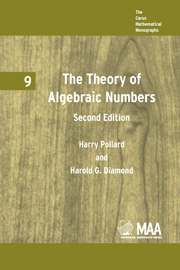Book contents
- Frontmatter
- Dedication
- Contents
- Preface to First Edition
- CHAPTER I Divisibility
- CHAPTER II The Gaussian Primes
- CHAPTER III Polynomials over a field
- CHAPTER IV Algebraic Number Fields
- CHAPTER V Bases
- CHAPTER VI Algebraic Integers and Integral Bases
- CHAPTER VII Arithmetic in Algebraic Number Fields
- CHAPTER VIII The Fundamental Theorem of Ideal Theory
- CHAPTER IX Consequences of the Fundamental Theorem
- CHAPTER X Ideal Classes and Class Numbers
- CHAPTER XI The Fermat Conjecture
- References
- List of Symbols
- Index
CHAPTER VI - Algebraic Integers and Integral Bases
- Frontmatter
- Dedication
- Contents
- Preface to First Edition
- CHAPTER I Divisibility
- CHAPTER II The Gaussian Primes
- CHAPTER III Polynomials over a field
- CHAPTER IV Algebraic Number Fields
- CHAPTER V Bases
- CHAPTER VI Algebraic Integers and Integral Bases
- CHAPTER VII Arithmetic in Algebraic Number Fields
- CHAPTER VIII The Fundamental Theorem of Ideal Theory
- CHAPTER IX Consequences of the Fundamental Theorem
- CHAPTER X Ideal Classes and Class Numbers
- CHAPTER XI The Fermat Conjecture
- References
- List of Symbols
- Index
Summary
Algebraic integers. Let R(θ) be an algebraic number field. What shall we mean by an integer in this field? With the example of the Gaussian integers as the “integers” in R(i) before us, the following conditions seem reasonable to demand of our definition:
(i) The integers form a ring, i.e., if α and β are integers in R(θ), so are α + β, α − β and αβ;
(ii) if α is an integer in R(θ) and is also a rational number, then it is a rational integer;
(iii) if α is an integer so are its conjugates; (in which of the two senses “conjugate” is to be taken is clearly a matter of indifference here.)
(iv) if γ ∈ R(θ), then nγ is an algebraic integer for some non-zero rational integer n.
It turns out that the following definition meets all the requirements: an algebraic number is an algebraic integer if its minimal polynomial has only rational integers as coefficients. Since a minimal polynomial is monic α must satisfy an equation
p(x) = xn + an−1xn−1 + an−2xn−2 + … + a0 = 0,
where the ai are rational integers. It follows that the requirement (iii) is automatically fulfilled. To see that (ii) is also fulfilled is simple, for if α satisfies p(x) and is rational, then its degree over R is 1, so n = 1, and so its minimal polynomial is simply x + a0 = 0.
- Type
- Chapter
- Information
- The Theory of Algebraic Numbers , pp. 74 - 87Publisher: Mathematical Association of AmericaPrint publication year: 1975



